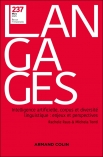
LANGAGES N° 238 (2/2025)
Pour acheter ce numéro, contactez-nous
Recevez les numéros de l'année en cours et accédez à l'intégralité des articles en ligne.
Les interrogatives ont donné lieu à un grand nombre descriptions linguistiques en français, tant en diachronie qu’en synchronie, mais à partir de données souvent restreintes. Avec la mise à disposition grandissante de corpus, on peut désormais envisager des études sur des textes plus diversifiés et plus volumineux. Cet article porte principalement sur l’interrogatif comment. Je montre qu’il présente un fonctionnement spécifique par rapport aux autres mots interrogatifs et des usages contrastés en fonction du type de corpus. J’aborde également la question méthodologique du degré d’automatisation actuellement envisageable sans remise en cause de la qualité de la description linguistique.
Interrogatives have given rise to a large number of studies in French, both diachronically and synchronically, but often on the basis of limited data. With the increasing availability of corpora, it is now possible to carry out studies using more diverse and voluminous data. In this article, I focus on the interrogative comment. I show that it functions differently from other interrogative words, with contrasting uses depending on the type of corpus. I also address the methodological question of the degree of automation that can be envisaged without compromising the quality of the linguistic description.

